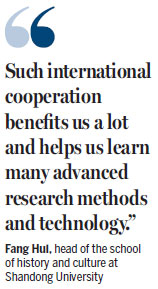Shandong University is working with some of the world's leading universities and institutes to promote the study of Chinese history and culture.
"Based in Shandong province, one of the origins of the Chinese civilization, Shandong University has long been known for its strength in literature and history research and has many academic findings with international influence, which forms a basis for global cooperation," said Zhang Rong, president of the university.
"It is our duty to capture the essence of Chinese history and culture, and show it to the world," Zhang said.
The university is working on the establishment of a global Sinology alliance by cooperating with the world's top universities and institutions.
"The alliance's headquarters in our university is planned to be built in the second half of this year. One of its important works is to collect and study China's ancient and rare writings, and discover their modern value," said Zhang.
He said that the Harvard-Yenching Institute at Harvard University has confirmed its participation. Dozens of other world-class universities, including Oxford, the University of Tokyo, the University of Munich, the University of Vienna and Leiden University in the Netherlands, have also expressed their interest in joining in the alliance.
Shandong University has already carried out a massive project to collect rare Chinese classic texts that were stored in various libraries, museums and research institutions across the word.

The Chinese classic texts are mainly from books and writings before the Qing Dynasty (1644-1911). They can be classified into four categories according to the content - jing (Confucian classics), shi (historical works), zi (philosophical works and writings on agriculture, medicine, mathematics and astronomy) and ji (literature works).
"They are precious first-hand materials to study Chinese history and culture. However many of them are now owned by overseas libraries and private collectors due to various reasons," said Wang Chenglue, professor of the institute of literature history and philosophy at Shandong University, who is also a member of the project.
"It will hinder the development of academic research and even the inheritance of Chinese traditional culture," Wang added.
Wang said the project is expected to collect and publish copies of 20,000 Chinese classic texts and establish a global database with digital scanning technology. Some rare Chinese classic texts will also be translated into different languages.
The project has support from the National Social Sciences Foundation, the Association for Relations Across the Taiwan Straits, the National Palace Museum in Taiwan, the British Library, the French National Library and other libraries and institutions in Russia and Japan.
Shandong University is also promoting international cooperation in archaeological studies, one of its advantageous disciplines.
The university has established partnerships with more than 20 globally leading universities and archaeological institutes, including Yale University, the University of Toronto, the Field Museum of Natural History in Chicago and the University of California.
Since 1995, a Sino-US archaeological research team led by Shandong and Yale universities spent a decade carrying out a regional archaeological survey and excavation in Rizhao, a coastal city in Shandong.
They found a Neolithic site - the Liangchengzhen site, which is believed to date back to 2,600 BC, and ruins of a prehistoric state dating back to between 3,000 and 2,200 BC.
The findings caused a stir in international archaeological circles as they show that there might have been dozens of prehistoric states in eastern China from 5,000 years ago, thousands of years before China's first textually attested state - the Xia Dynasty (c.21st century-16th century BC).
"Such international cooperation benefits us a lot and helps us learn many advanced research methods and technology," said Fang Hui, head of the school of history and culture at Shandong University, who is also a member of the team.
"For example, inspired by the Sino-US project, we established an archaeological laboratory, the first one of its kind in Chinese universities, and promoted the interdisciplinary approach in archaeology," said Fang.
The university has a museum, which houses more than 150,000 cultural relics, including 20 precious pieces on the national list of important findings. Two of its archeological findings were among the top 10 Chinese archeological discoveries in 1995 and 2010.
wangqian2@chinadaily.com.cn
(China Daily 08/22/2015 page5)
|